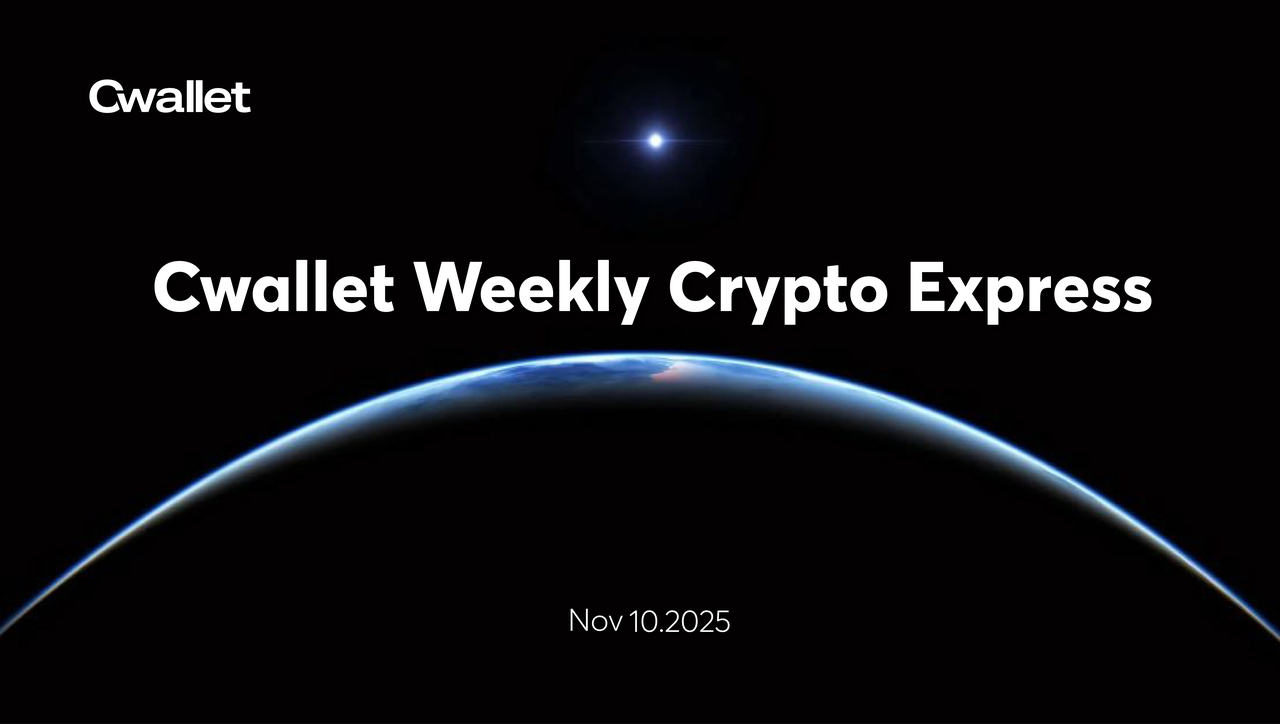Cwallet Weekly Crypto Express | Defending BTC's 100K Is the Next Battle
Elevated put demand and higher premiums at the $100K strike show traders are still hedging, not buying the dip.

Executive Summary
- Bitcoin fell below the Short-Term Holders’ Cost Basis (~$112.5K), confirming fading demand and ending its prior bullish phase. Price now consolidates near $100K, about 21% below the ATH.
- Around 71% of supply remains in profit, consistent with mid-cycle corrections. The Relative Unrealized Loss at 3.1% suggests a mild bear phase rather than deep capitulation.
- Since July, LTH supply has declined by 300K BTC, marking ongoing distribution even as price trends lower, unlike earlier in the cycle when selling occurred into rallies.
- U.S. Spot ETFs have recorded steady outflows (–$150M/day to –$700M/day), while spot CVDs on major exchanges show persistent sell pressure and fading discretionary demand.
- The Perpetual Market Directional Premium dropped from $338M/month in April to $118M/month, indicating traders are stepping back from leveraged longs.
- Elevated put demand and higher premiums at the $100K strike show traders are still hedging, not buying the dip. Short-term implied volatility remains sensitive to price swings but is stabilizing after October’s spike.
- Overall, market remains in a fragile equilibrium, with weak demand, controlled losses, and high caution. A sustained recovery requires renewed inflows and reclaiming the $112K–$113K region as support.
On-chain Insights
Following last week’s report, Lacking Conviction, Bitcoin broke below the $100K psychological threshold after repeatedly failing to reclaim the Short-Term Holders’ cost basis. This breakdown confirms fading demand momentum and persistent sell pressure from long-term investors, marking a clear step away from the bullish phase.In this edition, we use on-chain price models and spending indicators to assess the market’s structural weakness, then turn to spot, perpetual, and options market metrics to gauge sentiment and risk positioning for the week ahead.
Testing the Lower Bound
Since the market reset on October 10th, Bitcoin has struggled to hold above the Short-Term Holders’ cost basis, resulting in a sharp decline to around $100K, approximately 11% below this key threshold at $112.5K.
Historically, discounts with such depth from this level have increased the likelihood of further downside toward lower structural supports, such as the Active Investors’ Realized Price, currently near $88.5K. This metric dynamically tracks the cost basis of actively circulating supply (excluding dormant coins) and has often served as a critical reference point during extended corrective phases in prior cycles.
At a Crossroad
Extending this analysis, the recent correction has formed a structure reminiscent of June 2024 and February 2025, periods where Bitcoin stood at a pivotal juncture between recovery and deeper contraction. At $100K, roughly 71% of the supply remains in profit—placing the market near the lower bound of the typical 70%–90% equilibrium range seen during mid-cycle slowdowns.
This stage often features brief relief rallies toward the Short-Term Holders’ cost basis, though a sustained recovery generally requires prolonged consolidation and renewed demand inflows. Conversely, if further weakness pushes a larger share of supply into loss, the market risks transitioning from the current moderate downtrend into a deeper bearish phase, historically defined by capitulation and extended re-accumulation.
Losses Still Contained
To further distinguish the current drawdown, it’s useful to assess the Relative Unrealized Loss, which measures the total unrealized losses in USD relative to market capitalization. Unlike the 2022–2023 bear market, where losses reached extreme levels, the current reading of 3.1% suggests only moderate stress, comparable to mid-cycle corrections in Q3–Q4 2024 and Q2 2025, all of which remained below the 5% threshold.
As long as unrealized losses stay within this range, the market can be classified as a mild bear phase characterized by orderly revaluation rather than panic. However, a deeper drawdown pushing this ratio above 10% would likely trigger broader capitulation and mark the transition into a more severe bearish regime.
Unpacking the Quiet Distribution
To better understand the ongoing long-term holder (LTH) distribution, it’s important to recognize that changes in LTH supply reflect two forces: coins spent and coins maturing beyond roughly 155 days. Since July 2025, the pace of spending has outstripped maturation, creating a “quiet” form of distribution beneath the surface.
Comparing cumulative LTH spending with the net supply change reveals that long-term holders have spent around 2.4M BTC during this period, while new maturations offset much of this outflow, resulting in a net supply decline of 0.3M BTC. Excluding the maturation effect, this spending represents roughly 12% of the circulating supply (2.4M / 19.4M). This is a substantial flow that helps explain the persistent sell-side pressure despite relatively stable price action.
Off-Chain Insights
Low on AmmoShifting focus to institutional demand, U.S. spot Bitcoin ETFs have seen a marked slowdown over the past two weeks, recording consistent net outflows between –$150M and –$700M per day. This contrasts sharply with the strong wave of inflows observed throughout September and early October, which had supported price resilience during that period.
The recent trend points to a moderation in institutional capital allocation, as profit-taking and reduced appetite for new exposure weigh on aggregate ETF buying pressure. This cooling in activity aligns closely with the broader price weakness, highlighting a decline in buy-side conviction following several months of persistent accumulation.
Spoiled Appetite
In the derivatives market, the Perpetual Market Directional Premium—the interest paid by long traders to maintain positions—has declined sharply from its April peak of $338M per month to around $118M per month. This notable reduction signals a broad unwind in speculative positioning and a clear cooling of risk appetite.
After an extended period of elevated positive funding through mid-year, the metric’s steady decline indicates that traders are scaling back directional leverage, favouring neutrality over aggressive long exposure. This shift mirrors the broader softening seen in spot demand and ETF inflows, underscoring a transition in perpetual markets from an optimistic bias to a more cautious, risk-off stance.
Still Paying for Protection
As Bitcoin hovers around the $100K psychological level, options skew continue to signal strong demand for puts unsurprisingly. The data show that the options market is not positioning for a reversal or “buying the dip,” but rather paying elevated premiums to guard against further downside. Expensive puts at a key support level indicate that traders remain focused on protection rather than accumulation. In short, the market is still hedging, not bottom fishing (at least, not yet).
Defensive at 100K
Examining the $100K strike put premium offers further insight into current sentiment. Over the past two weeks, net put premiums have been gradually rising, then surged sharply yesterday as fears grew that the bull cycle might be ending. The premium spiked during the selloff and continues to trade elevated, even as Bitcoin stabilizes near its support level. This trend confirms that hedging remains active, with traders still opting for protection over renewed risk-taking.
Conclusion
Bitcoin’s break below the Short-Term Holders’ Cost Basis (~$112.5K) and subsequent stabilization around $100K mark a decisive shift in market structure. So far, this correction mirrors prior mid-cycle slowdowns, with 71% (70%-90%) of supply still in profit and Relative Unrealized Loss contained at 3.1% (<5%), suggesting a mild bear phase rather than a deep capitulation. However, sustained long-term holder distribution since July and continued outflows from ETF products underscore weakening conviction across both retail and institutional fronts.
Overall, the market remains in a fragile equilibrium; oversold but not panicked, cautious yet structurally intact. The next directional impulse will likely hinge on whether renewed demand can absorb ongoing long-term holder distribution and reclaim the $112K–$113K region as firm support, or whether sellers maintain control and extend the current downtrend.
Cwallet: Your Gateway to a New Era of Crypto Finance
Cwallet, more than a wallet, is your all-in-one gateway to secure crypto management and dynamic trading.
In one powerful platform, you can store, swap, earn, and spend over 1,000+ cryptocurrencies across 60+ blockchains. Spend your digital assets like cash with the Cozy Card, while extra tools such as HR bulk management, mobile top-ups, and gift cards make every transaction smoother.
We're leveling up into a comprehensive financial hub — from zero-fee Memecoins and xStocks trading to fast, interactive price-prediction trades like Trend Trade and Market Battle, making crypto trading more accessible, engaging, and fun!Join millions already reimagining what a crypto wallet can do. Stay cozy, trade smart, and embrace the future of Web3 finance.
Official Link
Official Site: https://cwallet.com
Twitter: https://twitter.com/CwalletOfficial
Disclaimer
This content is strictly for informational and educational purposes only. It does not constitute financial, investment, legal, or tax advice, nor is it an offer or solicitation to buy, sell, or hold any digital asset. Crypto assets involve high volatility and risks, and their value can fluctuate greatly. Readers must be aware of and adhere to the relevant local laws and regulations concerning digital assets in their specific jurisdiction, as product availability may vary. All investment decisions must be based on your own research (DYOR) and risk assessment. Some content herein may be generated or assisted by artificial intelligence (AI) tools. The author and platform assume no liability for investment losses.
